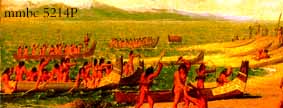|
As a point of clarification, the term WestCoast (no space) refers to the
First Nations people formerly known as the Nootka. The term west coast
(with a space) refers to the coast of British Columbia, Washington State and
Alaska.
The First Nations people of the northwest coast had already traded items with the Russians and the Spanish by the time of Cook's arrival. Objects made from metal, such as iron, copper, brass, and tin, were the main items in demand by the First Nations peo ples of this region. For example, the WestCoast peoples were already using iron chisels and knives and wearing copper earrings and bracelets by 1778.
|
||||||
|
|
|||||
| With the publication of Cook's "A Voyage to the Pacific Ocean", many Europeans learned about the trade of sea otter pelts between Cook and the WestCoast, and, knowing the prices these pelts sold for, they were soon on the west coast trading furs. In 1786 George Dixon and Nathaniel Portlock, with the King George's Sound Company (King George's Sound was the original name Cook gave to Nootka Sound), |
 John Meares |
collected 2,552 skins for which they earned $54,847 in China, returning to London with tea for the East India Company. Other items that were purchased in China were spices, ginger, silk, and porcelain. By 1788 Meares was actively involved in the fur trade at Nootka Sound, representing a company he was in partnership with, known as the Associated Merchants of London and India. Many Americans became involved in coastal fur trade as well. |
Adding to this intensified trade was the recent discovery of three routes by river and land which linked the interior to the Pacific Ocean, allowing for increased overland trade between east and west.
|
|
|
|
| By the early 19th century hundreds of ships were trading on the coast. This was a prosperous period for the First Nations population which already had a tradition of celebrations called potlatches. |

|
The host of a potlatch would display his wealth and give gifts to his guests. If he gave many gifts, his prestige in the community would be high. Potlatches became more frequent and larger after contact, even replacing intertribal war as a means of gainin g power and prestige over enemy tribes. This celebration was well established in Kwagiulth society. Potlatches were later banned when British law was imposed. |
The art produced by the coastal tribes flourished during this fur trade period. The increase in celebrations meant an increased need for carved items such as headdresses, masks, and other costume elements, as well as feast dishes and spoons.
 A Haida paddle mmbc 6539 |

|
Totem poles became more numerous, larger and elaborate. The new tools made of metal enabled First Nations artists to carve finer details with greater ease. Soon, foreign traders became interested in the quality and uniqueness of this artwork and began col lecting it. |
 Bird rattle mmbc 0154N |
| To acquire even more wealth, some coastal tribes, such as the WestCoast and Haida, competed for the position of middlemen between the foreign traders and the inland tribes from whom they could buy furs cheaply and later charge higher prices to foreign tra ders. By the 1830's, the Kwagiulth were competing with the Hudson's Bay Company, offering higher prices for furs in order to sell them to American traders. During this period of competition for trading power the Tlingit annihilate d a Hudson's Bay post which was hampering their fur trade monopoly. |
 Royal Navy brass buttons mmbc collection |
The struggle for fur trade control unfortunately led to the occasional outburst of violence between foreign and First Nations traders. The introduction of guns eventually had drastic results upon the First Nations population, particularly as guns quickly replaced the club and dagger traditionally used in warfare.
 First Nations war party mmbc 5214P |
Intertribal warfare using guns resulted in a greater number of deaths. Tribes such as the southern Kwagiulth wiped out the Comox tribe in the Cape Mudge and Campbell River area. The frequent deaths of First Nations people of high status meant there was an increase in the availability of these positions. Competition to fill these positions therefore increased, and potlatches became more frequent. |
| Vancouver had significant exposure to fur trading activities on the coast and was not impressed by the general approach of the European and American traders, noting in his book 'A Voyage of Discovery the N orth Pacific Ocean and Round the World': | |

|
...I am extremely concerned to be compelled to state here, that many of the traders from the civilized world have not only pursued a line of conduct, diametrically opposite to the true principles of justice in their commercial dealings, but have fomented discords, and stirred up contentions, between the different tribes, in order to increase the demand for these destructive engines. |
 A musket ca. 1750 mmbc 2836 |
By 1800 there existed an overabundance of items such as copper on the northwest coast. Consequently, the First Nations peoples became less interested in them, preferring goods such as:
|




![[English]](../simages/english.gif)

![[French]](../simages/french.gif)

![[Credits]](../simages/credit.gif)

![[Feedback]](../simages/feedback.gif)